Temporal and Spatial Variation and Driving Forces of Soil Erosion on the Loess Plateau before and after the Implementation of the Grain-for-Green Project: A Case Study in the Yanhe River Basin, China
Abstract
1. Introduction
2. Materials and Methods
2.1. Study Area
2.2. Data Collection
2.3. Research Methods
2.3.1. Soil Erosion Evaluation
2.3.2. Geographic Detector Model
2.3.3. Data Discretization Method
3. Results and Analysis
3.1. Temporal and Spatial Variation in Soil Erosion before and after Implementation of GGP
3.1.1. Temporal Variation in Soil Erosion before and after Implementation of GGP
3.1.2. Spatial Variation in Soil Erosion before and after Implementation of GGP
3.2. Detection of Spatial Distribution Drivers of Soil Erosion in Yanhe River Basin
3.2.1. Temporal Evolution of Driving Force
3.2.2. Spatial Variation in Driving Forces
3.3. Changes in Driving Forces of Spatial Distribution of Soil Erosion before and after Implementation of GGP
3.3.1. Changes in Dominant Driving Force before and after Implementation of GGP
3.3.2. Changes in Natural Driving Force and Human Activity Driving Force before and after Implementation of GGP
3.4. Changes in Interaction Driving Forces of Spatial Distribution of Soil Erosion before and after Implementation of GGP
3.4.1. Detection of Interaction Driving Forces of Spatial Distribution of Soil Erosion
3.4.2. Changes in Interaction Driving Forces before and after Implementation of GGP
4. Discussion
4.1. Differences in Effects of Rainfall Factors on Temporal and Spatial Variations in Soil Erosion
4.2. Effect of GGP on Spatial Distribution of Soil Erosion
4.3. Limitations and Prospects
5. Conclusions
Author Contributions
Funding
Institutional Review Board Statement
Informed Consent Statement
Data Availability Statement
Acknowledgments
Conflicts of Interest
References
- Mabit, L.; Zapata, F.; Dercon, G.; Benmansour, M.; Bernard, D.; Walling, D.E. Assessment of Soil Erosion and Sedimentation: The Role of Fallout Radionuclides; Iaea Tecdoc Series; IAEA Publication: Vienna, Austria, 2014; Volume 3, pp. 181–201. [Google Scholar]
- Cerdà, A.; Pelayo, Ó.G.; Pereira, P.; Novara, A.; Iserloh, T.; Prosdocimi, M. The wildgeographer avatar shows how to measure soil erosion rates by means of a rainfall simulator. EGU Gen. Assem. Conf. Abstr. 2015, 17, 15878. [Google Scholar]
- Amundson, R.; Berhe, A.A.; Hopmans, J.W.; Olson, C.; Sztein, A.E.; Sparks, D.L. Soil and human security in the 21st century. Science 2015, 348, 647. [Google Scholar] [CrossRef] [PubMed]
- Borrelli, P.; Robinson, D.A.; Fleischer, L.R.; Lugato, E.; Ballabio, C.; Alewell, C.; Meusburger, K.; Modugno, S.; Schütt, B.; Ferro, V. An assessment of the global impact of 21st century land use change on soil erosion. Nat. Commun. 2017, 8, 2013. [Google Scholar] [CrossRef] [PubMed]
- Sarapatka, B.; Cap, L.; Bila, P. The varying effect of water erosion on chemical and Biochemical soil properties in different parts of Chernozem slopes. Geoderma 2018, 314, 20–26. [Google Scholar] [CrossRef]
- Liu, C.; Li, Z.; Chang, X.; He, J.; Nie, X.; Liu, L.; Xiao, H.; Wang, D.; Peng, H.; Zeng, G. Soil carbon and nitrogen sources and redistribution as affected by erosion and deposition processes: A case study in a loess hilly-gully catchment. China. Agr. Ecosyst. Environ. 2018, 253, 11–22. [Google Scholar] [CrossRef]
- Phinzi, K.; Abriha, D.; Bertalan, L.; Holb, I.; Szabó, S. Machine learning for gully feature extraction based on a pan-sharpened multispectral image: Multiclass vs. Binary approach. ISPRS Int. J. Geo-Inf. 2020, 9, 252. [Google Scholar] [CrossRef]
- Sun, W.Y.; Shao, Q.Q.; Liu, J.Y. Soil erosion and its response to the changes of precipitation and vegetation cover on the Loess Plateau. J. Geogr. Sci. 2013, 23, 1091–1106. [Google Scholar] [CrossRef]
- Van Pelt, R.S.; Hushmurodov, S.X.; Baumhardt, R.L.; Chappell, A.; Nearing, M.A.; Polyakov, V.O.; Strack, J.E. The reduction of partitioned wind and water erosion by conservation agriculture. CATENA 2017, 148, 160–167. [Google Scholar] [CrossRef]
- Hu, T.; Wu, J.S.; Li, W.F. Assessing relationships of ecosystem services on multi-scale: A case study of soil erosion control and water yield in the Pearl River Delta. Ecol. Indic. 2019, 99, 193–202. [Google Scholar] [CrossRef]
- Bossio, D.; Geheb, K.; Critchley, W. Managing water by managing land: Addressing land degradation to improve water productivity and rural livelihoods. Agric. Water Manag. 2010, 97, 536–542. [Google Scholar] [CrossRef]
- Jacob, M.; Frankl, A.; Beeckman, H.; Mesfin, G.; Hendrickx, M.; Guyassa, E.; Nyssen, J. North Ethiopian afro-alpine tree line dynamics and forest-cover change sincethe early 20th century. Land Degrad. Dev. 2015, 26, 654–664. [Google Scholar] [CrossRef]
- Tolessa, T.; Dechassa, C.; Simane, B.; Alamerew, B.; Kidane, M. Land use/landcover dynamics in response to various driving forces in Didessa sub-basin, Ethiopia. GeoJournal 2020, 85, 747–760. [Google Scholar] [CrossRef]
- Gao, G.; Zhang, J.; Liu, Y.; Ning, Z.; Fu, B.; Sivapalan, M. Spatio-temporal patterns of the effects of precipitation variability and land use/cover changes on long-term changes in sediment yield in the Loess Plateau, China. Hydrol. Earth Syst. Sci. 2017, 21, 4363–4378. [Google Scholar] [CrossRef]
- Tuo, D.F.; Xu, M.X.; Gao, G.Y. Relative contributions of wind and water erosion to total soil loss and its effect on soil properties in sloping croplands of the Chinese Loess Plateau. Sci. Total Environ. 2018, 633, 1032–1040. [Google Scholar] [CrossRef]
- Zhao, G.J.; Mu, X.M.; Jiao, J.Y.; Gao, P.; Sun, W.Y.; Li, E.H.; Wei, Y.H.; Huang, J.C. Assessing response of sediment load variation to climate change and humanactivities with six different approaches. Sci. Total Environ. 2018, 639, 773–784. [Google Scholar] [CrossRef] [PubMed]
- Arnaud, F.; Poulenard, J.; Giguet-Covex, C.; Wilhelm, B.; Révillon, S.; Jenny, J.P.; Revel, M.; Enters, D.; Bajard, M.; Fouinat, L.; et al. Erosion under climate and human pressures: An alpine lake sediment perspective. Quat. Sci. Rev. 2016, 152, 1–18. [Google Scholar] [CrossRef]
- Ouyang, W.; Wu, Y.Y.; Hao, Z.C.; Zhang, Q.; Bu, Q.W.; Gao, X. Combined impacts of land use and soil property changes on soil erosion in a mollisol area under long-term agricultural development. Sci. Total Environ. 2018, 613–614, 798–809. [Google Scholar] [CrossRef]
- Wang, S.S.; Sun, B.Y.; Li, C.D.; Li, Z.B.; Ma, B. Runoff and Soil Erosion on Slope Cropland: A Review. J. Resour. Ecol. 2018, 9, 461–470. [Google Scholar]
- Jiang, C.; Zhang, H.; Zhang, Z.; Wang, D. Model-based assessment soil loss by wind and water erosion in China’s Loess Plateau: Dynamic change, conservation effective-ness, and strategies for sustainable restoration. Glob. Planet. Chang. 2019, 172, 396–413. [Google Scholar] [CrossRef]
- Wang, X.; Wang, Z.; Xiao, J.; He, M.; Jin, Z. Soil erosion fluxes on the central chinese loess plateau during CE 1811 to 1996 and the roles of monsoon storms and human activities. CATENA 2021, 200, 105148. [Google Scholar] [CrossRef]
- Chen, Y.P.; Wang, K.B.; Lin, Y.S.; Shi, W.Y.; Song, Y.; He, X.H. Balancing green and grain trade. Nat. Geosci. 2015, 10, 739–741. [Google Scholar] [CrossRef]
- Mancino, G.; Nolè, A.; Salvati, L.; Ferrara, A. In-between forest expansion and cropland decline: A revised USLE model for soil erosion risk under land-use change in a Mediterranean region. Ecol. Indic. Integr. Monit. Assess. Manag. 2016, 71, 544–550. [Google Scholar] [CrossRef]
- Shi, Z.H.; Wang, L.; Liu, Q.J.; Zhang, H.Y.; Huang, X.; Fang, N.F. Soil erosion: From comprehensive control to ecological regulation. Bull. Chin. Acad. Sci. 2018, 33, 198–205. [Google Scholar]
- Hu, C.H.; Zhang, X.M. Loess Plateau soil erosion governance and runoff-sediment variation of Yellow River. Water Resour. Hydropower Eng. 2020, 51, 1–11. [Google Scholar]
- Zhang, B.J.; Zhang, G.H.; Zhu, P.Z.; Yang, H.Y. Temporal variations in soil erodibility indicators of vegetation-restored steep gully slopes on the Loess Plateau of China. Agric. Ecosyst. Environ. 2019, 286, 106661. [Google Scholar] [CrossRef]
- Liu, Y.; Lv, Y.H.; Fu, B.J. Implication and limitation of landscape metrics in delineating relationship between landscape pattern and soil erosion. Acta Ecol. Sin. 2011, 31, 0267–0275. [Google Scholar]
- Wang, S.P.; Zhang, Z.Q.; McVicar, T.R.; Zhang, J.J.; Zhu, J.Z.; Guo, J.T. An event-based approach to understanding the hydrological impacts of different land uses insemi-arid catchments. J. Hydrol. 2012, 416–417, 50–59. [Google Scholar] [CrossRef]
- Zhou, Z.X.; Li, J. The correlation analysis on the landscape pattern index and hydrological processes in the Yanhe watershed, China. J. Hydrol. 2015, 524, 417–426. [Google Scholar] [CrossRef]
- Anache, J.A.A.; Flanagan, D.C.; Srivastava, A.; Wendland, E.C. Land use and climate change impacts on runoff and soil erosion at the hillslope scale in the Brazilian Cerrado. Sci. Total Environ. 2018, 622–623, 140–151. [Google Scholar] [CrossRef]
- Liu, X.Y.; Dang, S.Z.; Gao, Y.F.; Yang, S.T. The rule and threshold of the effect of vegetation change on sediment yield in the loess hilly region, China. J. Hydraul. Eng. 2020, 51, 505–518. [Google Scholar]
- Zhao, G.; Mu, X.; Jiao, J.; An, Z.; Klik, A.; Wang, F.; Jiao, F.; Yue, X.; Gao, P.; Sun, W. Evidence and caused of spatial temporal changes in runoff and sediment yield on the Chinese Loess Plateau. Land Degrad. Dev. 2017, 28, 579–590. [Google Scholar] [CrossRef]
- Zheng, F.; Wang, B. Soil erosion in the Loess Plateau region of China. Ecohydrology 2013, 5, 77–92. [Google Scholar]
- Liu, Z.J.; Liu, Y.S.; Li, Y.R. Anthropogenic contributions dominate trends of vegetation cover change over the farming-pastoral ecotone of northern China. Ecol. Indic. 2018, 95, 370–378. [Google Scholar] [CrossRef]
- Tang, Q.; Wang, S.; Fu, B.J.; Wang, Y.F.; Gao, G.Y. Check dam infilling archives elucidate historical sedimentary dynamics in a semiarid landscape of the LoessPlateau, China. Ecol. Eng. 2018, 118, 161–170. [Google Scholar] [CrossRef]
- Yao, W.Y. Development Opportunity and Scientific Positioning of Soil and Water Conservation of the Yellow River in the New Era. Yellow River 2019, 41, 1–7. [Google Scholar]
- Yu, Y.; Wei, W.; Chen, L.D.; Feng, T.J.; Daryanto, S. Quantifying the effects of precipitation, vegetation, and land preparation techniques on runoff and soil erosion in a Loess watershed of China. Sci. Total Environ. 2019, 652, 755–764. [Google Scholar] [CrossRef]
- Zhang, L.; Wang, J.M.; Bai, Z.K.; Lv, C.J. Effects of vegetation on runoff and soil erosion on reclaimed land in an opencast coal-mine dump in a loess area. CATENA 2015, 128, 44–53. [Google Scholar] [CrossRef]
- Liu, X.Y.; Wang, F.G.; Yang, S.T.; Li, X.Y.; Ma, H.B.; He, X.Z. Sediment reduction effect of level terrace in hilly-gully region in the Loess Plateau. J. Hydraul. Eng. 2014, 7, 793–799. [Google Scholar]
- Wang, N.; Jiao, J.Y.; Bai, L.C.; Zhang, Y.F.; Chen, Y.X.; Tang, B.Z.; Liang, Y.; Zhao, C.J.; Wang, H.L. Magnitude of soil erosion in small catchments with different land use patterns under an extreme rainstorm event over the Northern Loess Plateau, China. CATENA 2020, 195, 104780. [Google Scholar] [CrossRef]
- Fu, B.J.; Wang, S.; Liu, Y.; Liu, J.B.; Liang, W.; Miao, C.Y. Hydrogeomorphic ecosystem responses to natural and anthropogenic changes in the Loess Plateau of China. Annu. Rev. Earth Planet. Sci. 2017, 45, 223–243. [Google Scholar] [CrossRef]
- Wang, S.; Fu, B.J.; Piao, S.L.; Lv, Y.H.; Ciais, P.; Feng, X.M.; Wang, Y.F. Reduced sediment transport in the Yellow River due to anthropogenic changes. Nat. Geosci. 2016, 9, 38–41. [Google Scholar] [CrossRef]
- Jiang, C.; Zhao, L.L.; Dai, J.L.; Liu, H.M.; Li, Z.Y.; Wang, X.C.; Yang, Z.Y.; Zhang, H.Y.; Wen, M.L.; Wang, J. Examining the soil erosion responses to ecological restoration programs and landscape drivers: A spatial econometric perspective. J. Arid. Environ. 2020, 12, 104255. [Google Scholar] [CrossRef]
- Wang, Z.J.; Jiao, J.Y.; Rayburg, S.; Wang, Q.L.; Su, Y. Soil erosion resistance of “grain for green” vegetation types under extreme rainfall conditions on the Loess Plateau, China. CATENA 2016, 141, 109–116. [Google Scholar] [CrossRef]
- Liu, Y.-F.; Liu, Y.; Shi, Z.-H.; López-Vicente, M.; Wu, G.-L. Effectiveness of re-vegetated forest and grassland on soil erosion control in the semi-arid Loess Plateau. CATENA 2020, 11, 104787. [Google Scholar] [CrossRef]
- Liu, X.Y.; Yang, S.T.; Dang, S.Z.; Luo, Y.; Li, X.Y.; Zhou, X. Response of sediment yield to vegetation restoration at a large spatial scale in the loess plateau. Sci. China 2014, 57, 1482–1489. [Google Scholar] [CrossRef]
- Gao, S.X.; Chen, L.; Shankman, D.; Wang, C.M.; Wang, X.B.; Zhang, H. Excessive reliance on afforestation in China’s arid and semi-arid regions: Lessons in ecological restoration. Earth Sci. Rev. 2011, 104, 240–245. [Google Scholar]
- Feng, X.; Fu, B.; Piao, S.; Wang, S.; Ciais, P.; Zeng, Z.; Lu, Y.; Zeng, Y.; Li, Y.; Jiang, X. Revegetation in China’s Loess Plateau is approaching sustainable water resource limits. Nat. Clim. Chang. 2016, 6, 1019–1022. [Google Scholar] [CrossRef]
- Wen, X.; Deng, X.; Zhang, F. Scale effects of vegetation restoration on soil and water conservation in a semi-arid region in China: Resources conservation and sustainable management. Res. Conser. Recyl. 2019, 151, 104474. [Google Scholar] [CrossRef]
- Lian, Y.X.; Sun, M.; Wang, J.C.; Luan, Q.H.; Jiao, M.Y.; Zhao, X.; Gao, X.R. Quantitative impacts of climate change and human activities on the runoff evolution process in the Yanhe River Basin. Phys. Chem. Earth 2021, 122, 102998. [Google Scholar] [CrossRef]
- Zhao, G.; Mu, X.; Wen, Z.; Wang, F.; Gao, P. Soil erosion, conservation, and eco-environment changes in the Loess Plateau of China. Land Degrad. Dev. 2013, 24, 499–510. [Google Scholar] [CrossRef]
- Gu, C.J.; Mu, X.M.; Sun, W.Y.; Gao, P.; Zhao, G.J. Comparative analysis of the responses of rainstorm flood and sediment yield to vegetation rehabilitation in the Yanhe River Basin. J. Nat. Resour. 2017, 32, 1755–1767. [Google Scholar]
- Zhang, X.; Lin, P.; Chen, H.; Yan, R.; Zhang, J.; Yu, Y.; Yang, Y.; Zhao, W.; Lv, D. Understnading land use and cover change impacts on runoff and sediment load at flood events on the Loess Plateau, China. Hydrol. Process. 2018, 32, 576–589. [Google Scholar] [CrossRef]
- Ochoa, P.A.; Fries, A.; Mejía, D.; Burneo, J.I.; Ruíz-Sinoga, J.D.; Cerdà, A. Effects of climate, land cover and topography on soil erosion risk in a semiarid basin of the Andes. CATENA 2016, 140, 31–42. [Google Scholar] [CrossRef]
- Borrelli, P.; Alewell, C.; Alvarez, P.; Anache, J.A.A.; Baartman, J.; Ballabio, C.; Bezak, N.; Biddoccu, M.; Cerdà, A.; Chalise, D.; et al. Soil erosion modelling: A global review and statistical analysis. Soil erosion modelling: A global review and statistical analysis. Sci. Total Environ. 2021, 780, 146494. [Google Scholar] [CrossRef]
- Han, J.C.; Liu, Y.S.; Zhang, Y.G. Sand stabilization effect of feldspathic sandstone during the fallow period in Mu Us Sandy Land. J. Geogr. Sci. 2015, 25, 428–436. [Google Scholar] [CrossRef]
- Wang, J.F.; Zhang, T.L.; Fu, B.J. A measure of spatial stratified heterogeneity. Ecol. Indic. 2016, 67, 250–256. [Google Scholar] [CrossRef]
- Renard, K.G.; Agricultural Service, W.D.; Foster, G.R.; Weesies, G.A.; Mccool, D.K.; Yoder, D.C. Predicting soil erosion by water: A guide to conservation planning with the Revised Universal Soil Loss Equation (RUSLE). In Agriculture Handbook No. 703; Department of Agriculture, Agricultural Research Service: Beltsville, MD, USA, 1997. [Google Scholar]
- Yuan, X.F.; Han, J.C.; Shao, Y.J.; Li, Y.H.; Wang, Y.S. Geodetection analysis of the driving forces and mechanisms of erosion in the hilly-gully region of northern Shaanxi Province. Geogr. Sci. 2019, 29, 779–790. [Google Scholar] [CrossRef]
- Xu, E.Q.; Zhang, H.Q. Change pathway and intersection of rainfall, soil, and land use influencing water-related soil erosion. Ecol. Indic. 2020, 113, 106281. [Google Scholar] [CrossRef]
- Wang, B.W.; Yang, Q.K.; Liu, Z.H.; Meng, Q.X. Changes of soil erosion intensity due to conversion of farmland to forest and grassland in Yanhe River Basin. Sci. Soil Water Conserv. 2007, 5, 27–33. [Google Scholar]
- Zhou, D.C.; Zhao, S.Q.; Zhu, C. The Grain for Green Project induced land cover change in the Loess Plateau: A case study with Ansai County, Shanxi Province, China. Ecol. Indic. 2012, 23, 88–94. [Google Scholar] [CrossRef]
- Wang, Z.J. Characteristics of Vegetation and Erosion Sediment Yield in the Yanhe Watershed; The University of Chinese Academy of Sciences: Beijing, China, 2014. [Google Scholar]
- Liu, Y.; Gang, C.C.; Wen, Z.M.; Chen, T.D. Quantitative assessment of the effects of rainfall and vegetation factors on soil erosion in the Yanhe River Basin. Bull. Soil Water Conserv. 2021, 41, 35–42. [Google Scholar]
- Li, C.Z.; Wang, H.; Yu, F.L.; Yang, A.M.; Yan, D.H. The impact of soil and water conservation in the Yanhe River Basin on runoff and sediment. China Soil Water Conserv. Sci. 2011, 9, 1–8. [Google Scholar]
- Xie, H.X.; Li, R.; Yang, Q.K. The effect of returning farmland to forest (grass) and rainfall changes on soil erosion in the Yanhe River Basin. Chin. Agric. Sci. 2009, 42, 569–576. [Google Scholar]
- Zhang, K.L.; Lian, L.; Zhang, Z.D. Reliability of soil erodibility estimation in areas outside the US: A comparison of erodibility for main agricultural soils in the US and China. Environ. Earth Sci. 2016, 75, 252. [Google Scholar] [CrossRef]
- Zhang, W.B.; Xie, Y. Research on the method of calculating rainfall erosion force using daily rainfall. Geoscience 2002, 22, 705–711. [Google Scholar]
- Xie, Y.; Liu, B.Y.; Zhang, W.B. Research on erosive rainfall criteria. J. Soil Water Conserv. 2000, 14, 6–11. [Google Scholar]
- McCool, D.K.; Brown, L.G.; Foster, G.R.; Mutchler, C.K.; Meyer, L.D. Revised slope steepness factor for the Universal Soil Loss Equation. Trans. ASAE 1987, 30, 1387–1396. [Google Scholar] [CrossRef]
- Wang, B.W.; Yang, Q.K.; Liu, Z.H. Topographic factor extraction from modified General Soil loss Equation based on DEM and ArcGIS. Sci. Soil Water Conserv. China 2007, 5, 18–23. [Google Scholar]
- Alejandro, M.A.; Kenji, O. Estimation of vegetation parameter for modeling soil erosion using linear spectral mixture analysis of Landsat ETM data. J. Photo Grammetry Remote Sens. 2007, 62, 309–324. [Google Scholar]
- Li, T.H.; Zheng, L. Dynamic changes of soil erosion in Yanhe River Basin from 2001 to 2010 based on RUSLE model. J. Nat. Resour. 2012, 27, 1164–1173. [Google Scholar]
- Chen, H.Y.; Cui, P.; Chen, X.Q.; Tang, J.B. Study on the surge wave induced by glacier avalanches and its effects on dam failure process. Int. J. Eros. Control Eng. 2017, 10, 9–15. [Google Scholar] [CrossRef][Green Version]
- Jiang, Z.S.; Wang, Z.Q.; Liu, Z.H. Quantitative study on the spatial variation of soil erosion in small watersheds of soil hilly areas. J. Soil Eros. Water Conserv. 1996, 2, 1–10. [Google Scholar]
- Wang, W.Z.; Jiao, J.Y. Quantitative evaluation of soil erosion factors in China. Bull. Soil Water Conserv. 1996, 16, 1–20. [Google Scholar]
- Wang, J.F.; Li, X.H.; Christakos, G.; Liao, Y.L.; Zhang, T.; Gu, X.; Zheng, X.Y. Geographical detectors-based health risk assessment and its application in the neural tube defects study of the Heshun region, China. Int. J. Geogr. Inf. Sci. 2010, 24, 107–127. [Google Scholar] [CrossRef]
- Wang, J.F.; Hu, Y. Environmental health risk detection with GeogDetector. Environ. Model. Softw. 2012, 33, 114–115. [Google Scholar] [CrossRef]
- Wang, J.F.; Xu, C.D. Geodetectors: Principles and Prospects. J. Geogr. 2017, 72, 116–134. [Google Scholar]
- Yan, R.; Zhang, X.P.; Yan, S.J.; Chen, H. Estimating soil erosion response to land use/cover change in a catchment of the Loess Plateau, China. Int. Soil Water Conserv. Res. 2018, 6, 13–22. [Google Scholar] [CrossRef]
- Alatorre, L.C.; Begueria, S.; Lana-Renault, N.; Navas, A.; García-Ruiz, J.M. Soil erosion and sediment delivery in a mountain catchment under scenarios of land use change using a spatially distributed numerical model. Hydrol. Earth Syst. Sci. 2012, 16, 1321–1334. [Google Scholar] [CrossRef]
- Teng, H.F.; Liang, Z.Z.; Chen, S.C.; Liu, Y.; Viscarra Rossel, R.A.; Chappell, A.; Yu, W.; Shi, Z. Current and future assessments of soil erosion by water on the Ti-betan Plateau based on RUSLE and CMIP5 climate models. Sci. Total Environ. 2018, 635, 673–686. [Google Scholar] [CrossRef]
- Liu, Z.Y.; Xu, S.S. Geology and geomorphology of Loess Plateau in xianyang and modern erosion. Sediment Res. 1998, 2, 94–98. [Google Scholar]
- Xu, J.X. High-Sand Flow in the Slope-Gully System in the Hilly and Gully Area of the Loess Plateau(I)-The Influence of Geomorphic Factors and Gravitational Erosion. J. Nat. Disasters 2004, 1, 55–60. [Google Scholar]
- Liu, X.Y.; Yang, S.T.; Jin, S.Y.; Luo, Y.; Zhou, X. Research on the calculation method of sand reduction by forest and grass vegetation at large spatial scale in loess hilly gully area. J. Water Resour. 2014, 45, 135–141. [Google Scholar]
- Lou, H.Z.; Yang, S.T.; Zhou, Q.W.; Luo, Y.; Hou, L.P. Analysis of the land use/ cover change and driving forces in the Yanhe Basin from 2000 to 2010. J. Arid. Land Resour. Environ. 2014, 28, 15–21. [Google Scholar]
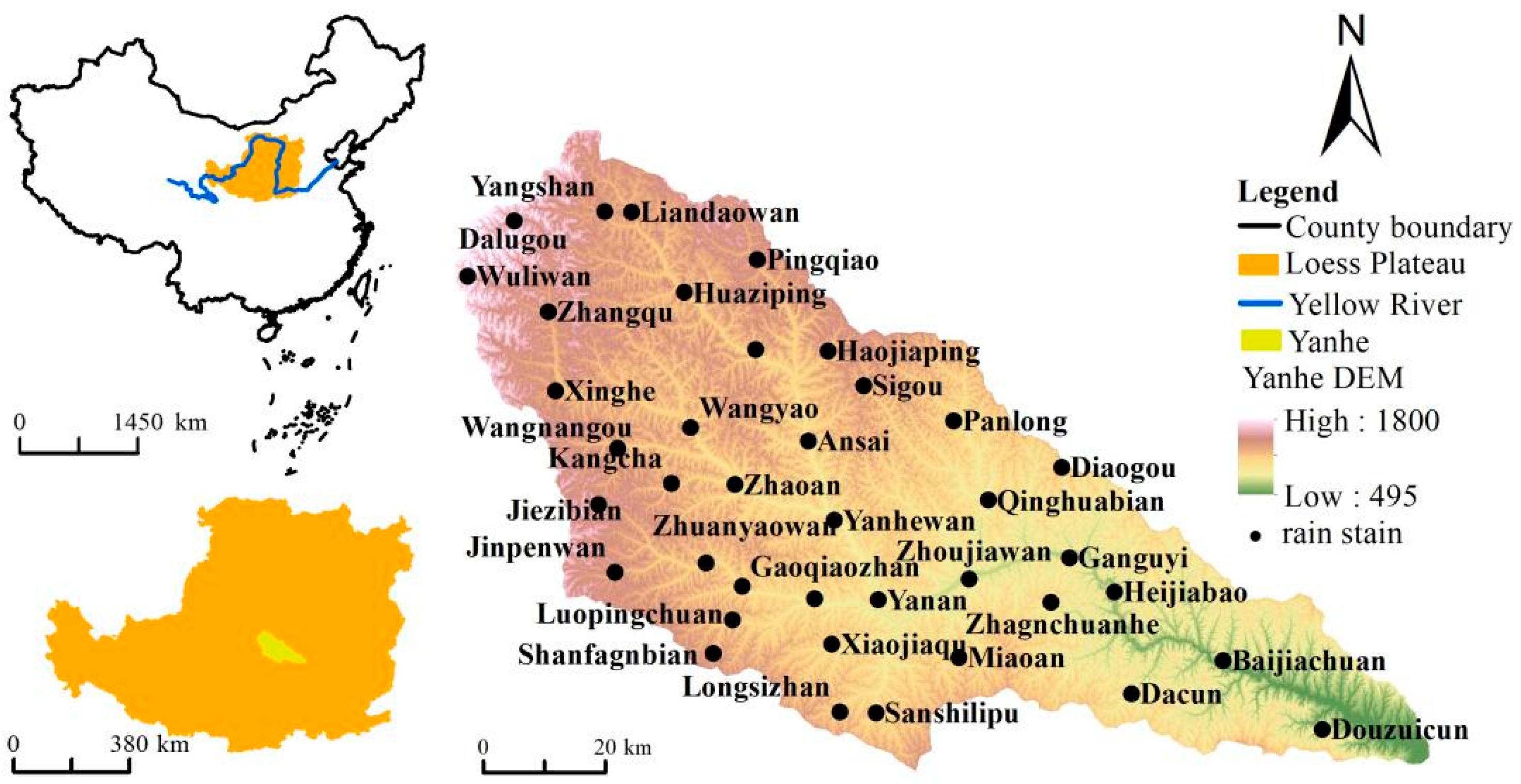
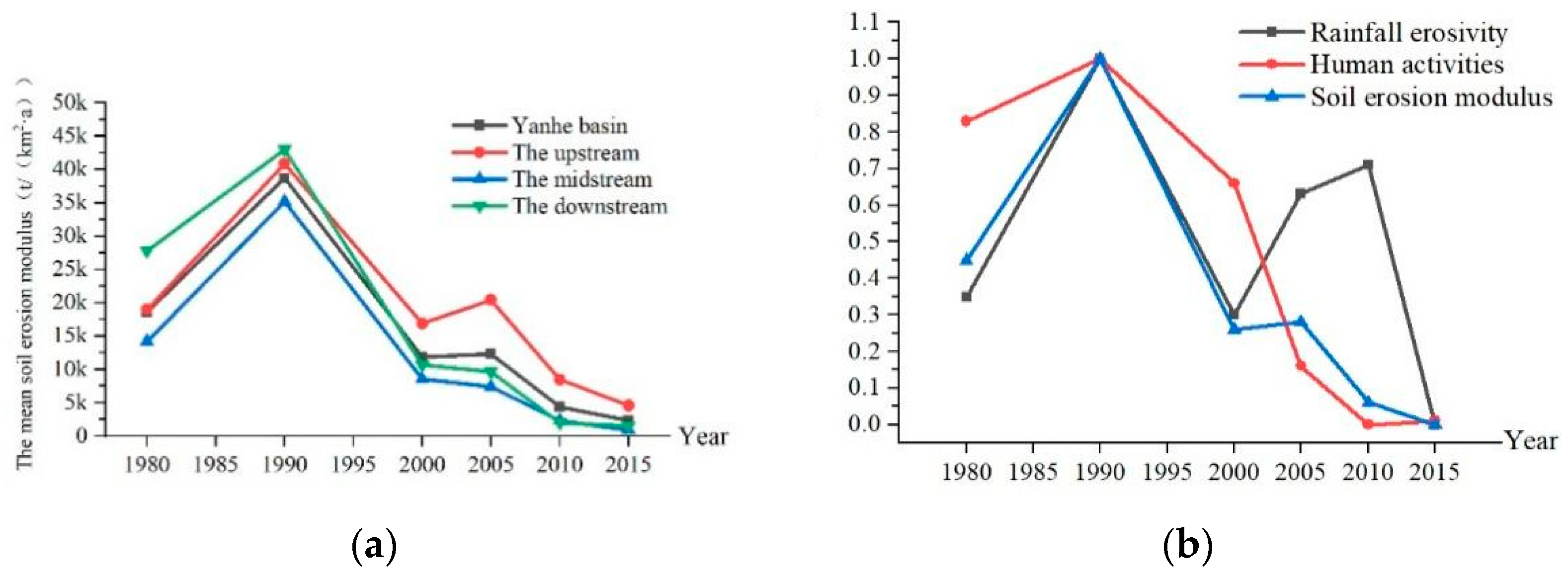
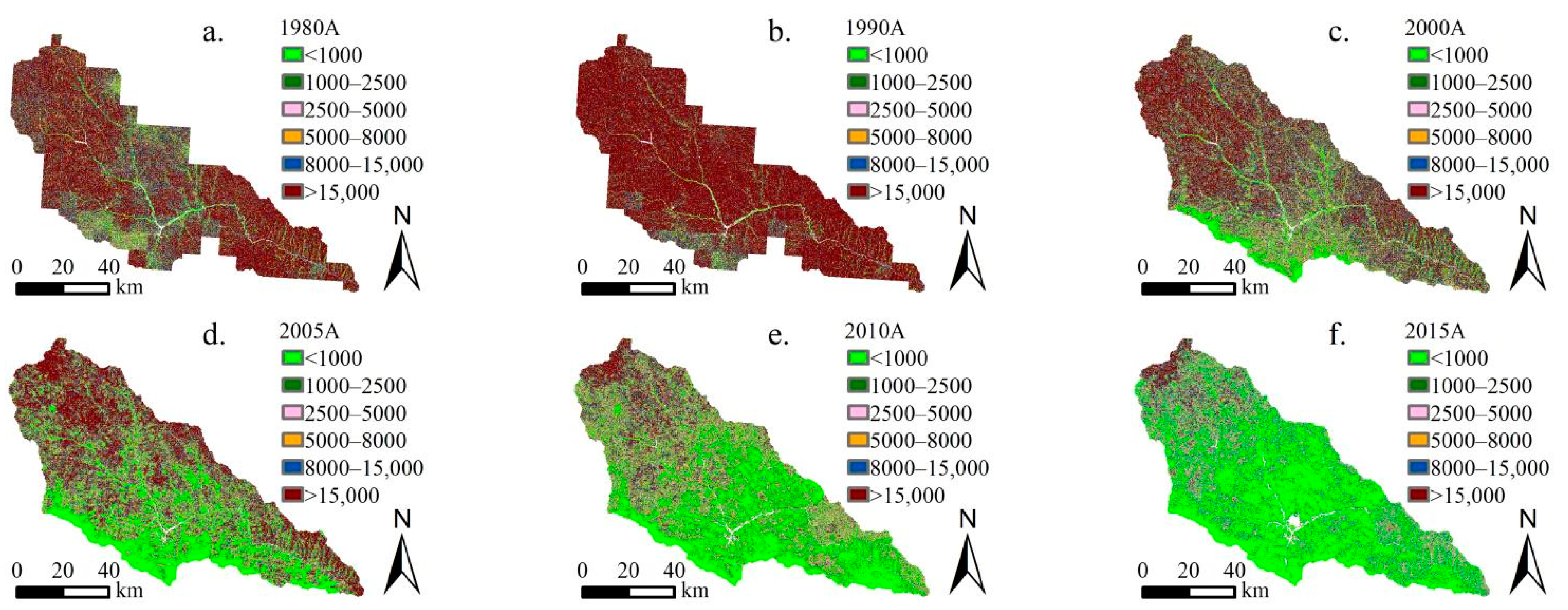
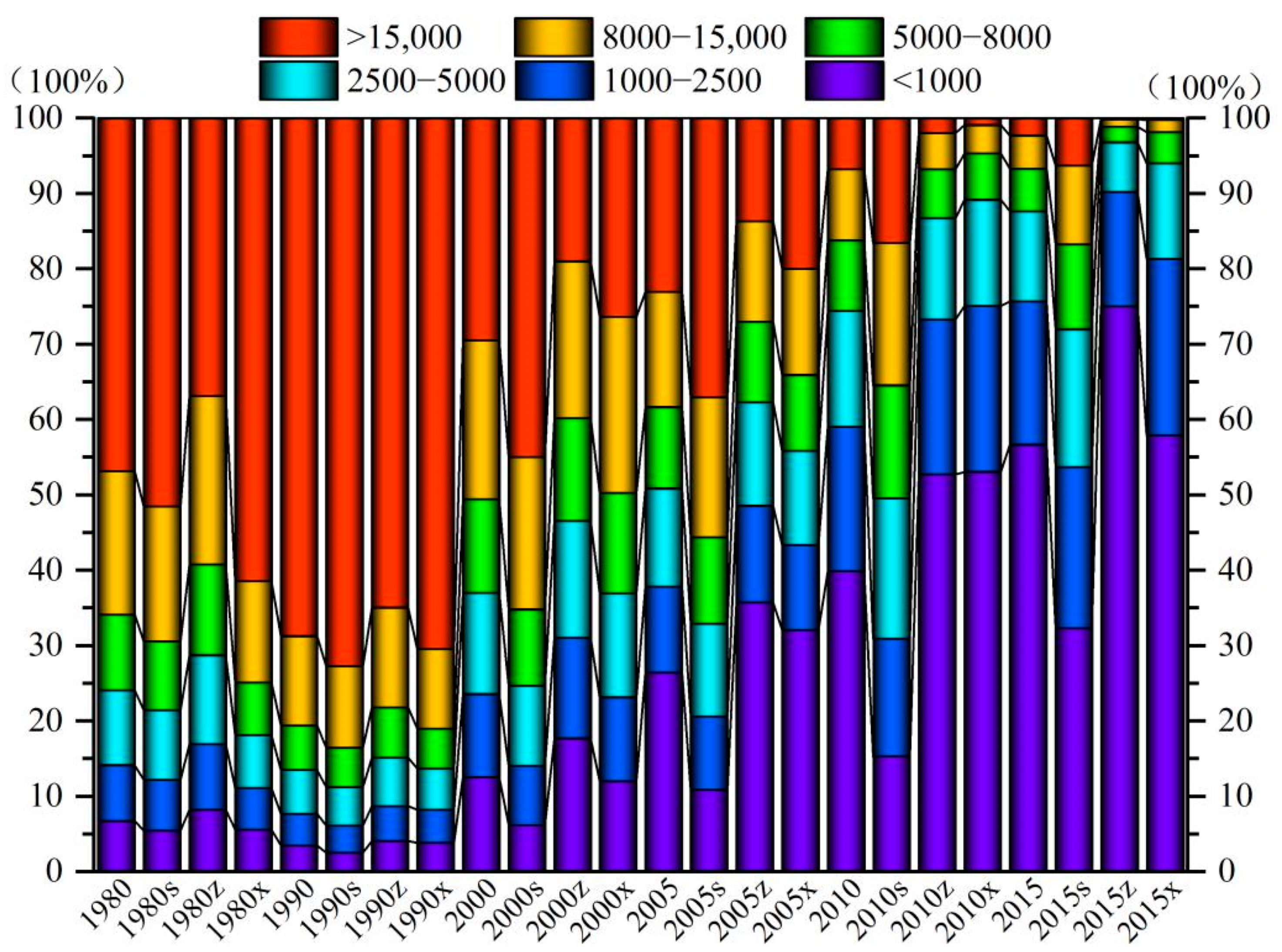
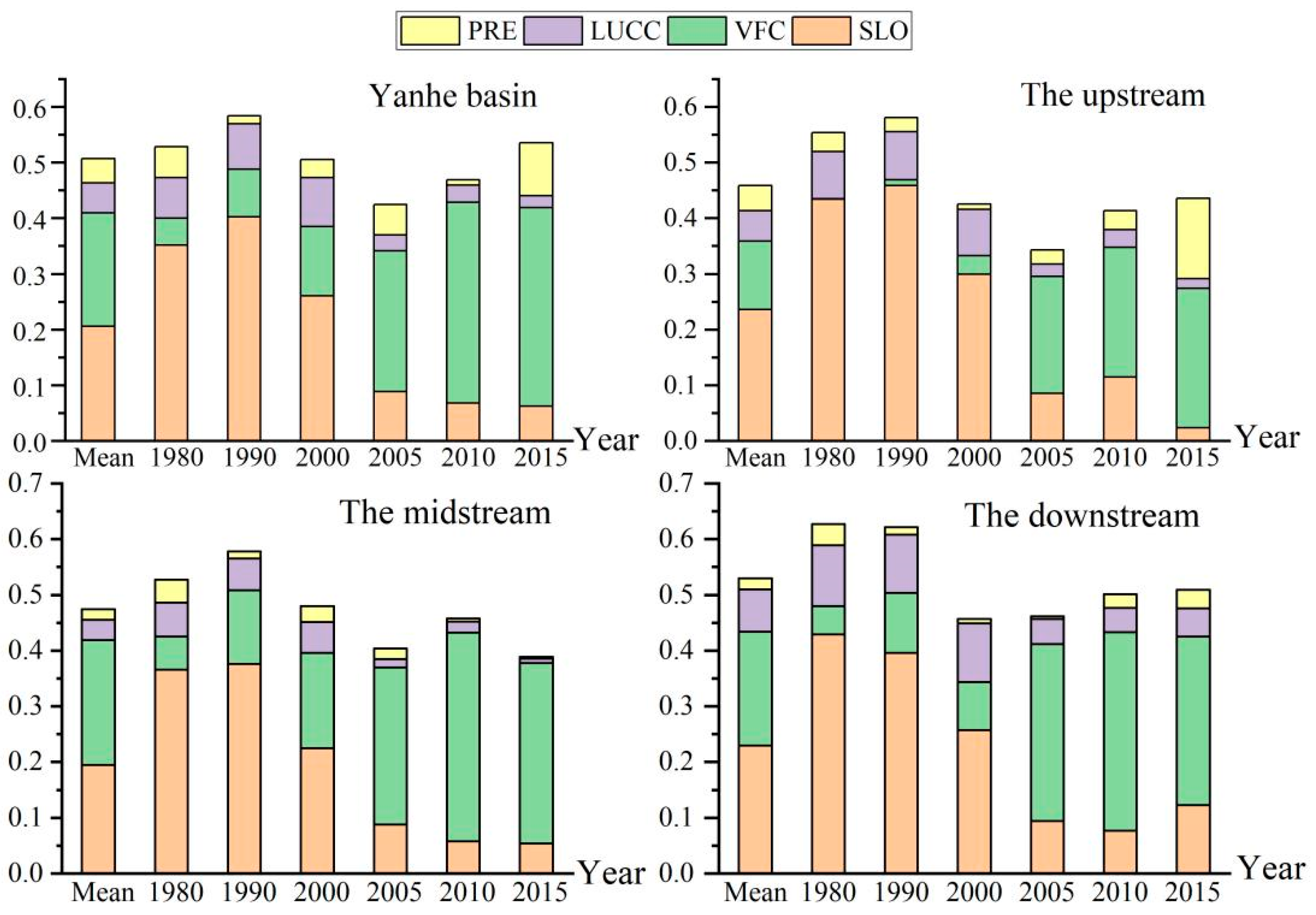
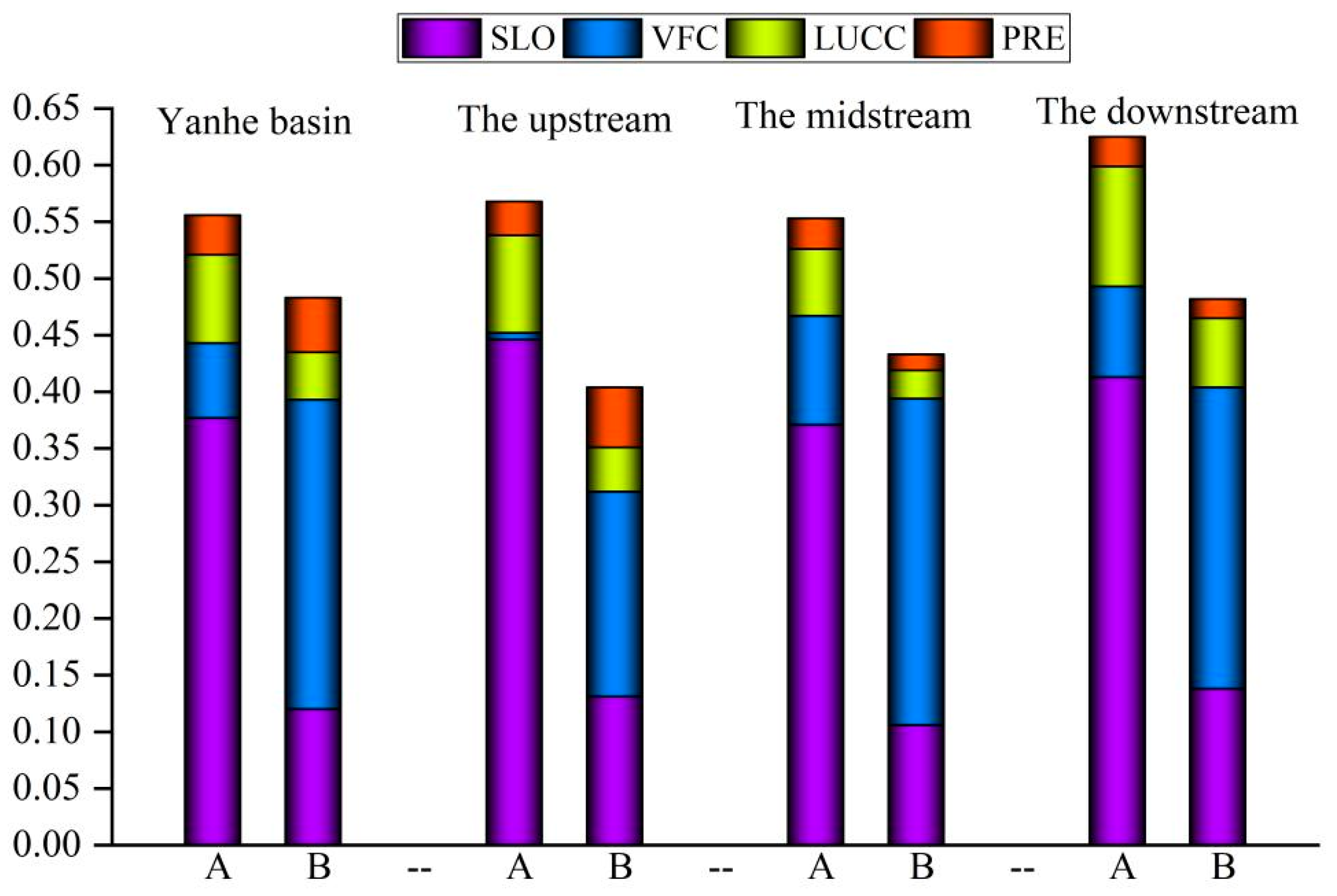
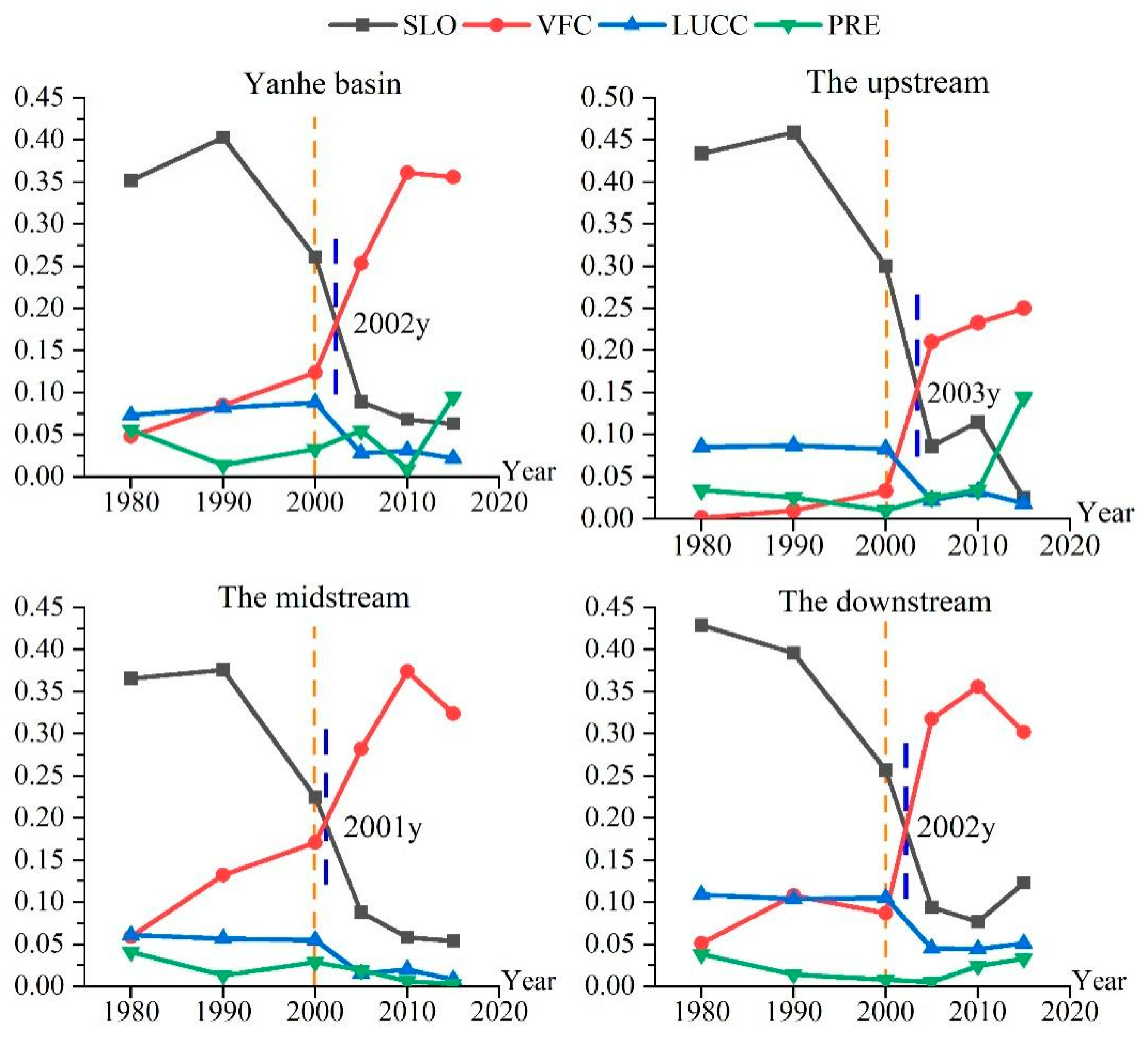
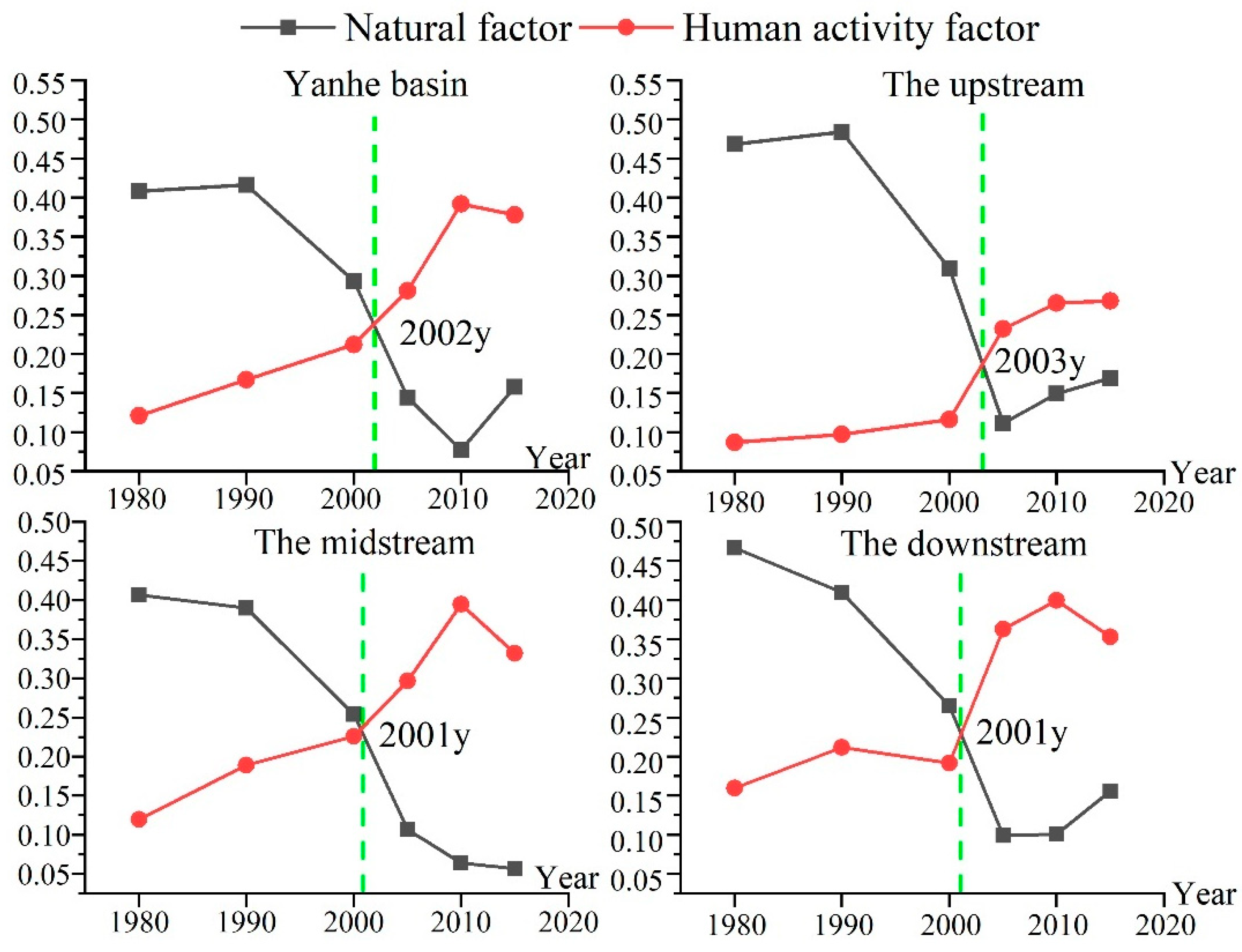
| Slope range | ≤5° | 5°–10° | 10°–15° | 15°–20° | 20°–25° | θ > 25° |
| p value | 0.100 | 0.221 | 0.305 | 0.575 | 0.705 | 0.800 |
| Reference for Judging | Interaction |
|---|---|
| q(X1 ∩ X2) < Min(q(X1),q(X2)) | Nonlinear reduction |
| Min(q(X1),q(X2)) < q(X1 ∩ X2) < Max(q(X1),q(X2)) | Single factor nonlinear reduction |
| q(X1 ∩ X2) > Max(q(X1),q(X2)) | Two-factor enhancement |
| q(X1 ∩ X2) = q(X1) + q(X2) | Independence |
| q(X1 ∩ X2) > q(X1) + q(X2) | Nonlinear enhancement |
| A ∩ B | C = A ∩ B | D = A + B | Judgment | Interactive | |
|---|---|---|---|---|---|
| 1980 | lucc ∩ slo | 0.404 | 0.426 | A ∩ B < A + B | ↑ |
| lucc ∩ vfc | 0.132 | 0.121 | A ∩ B > A + B | ↑↑ | |
| lucc ∩ pre | 0.140 | 0.129 | A ∩ B > A + B | ↑↑ | |
| slo ∩ vfc | 0.415 | 0.400 | A ∩ B > A + B | ↑↑ | |
| slo ∩ pre | 0.432 | 0.408 | A ∩ B > A + B | ↑↑ | |
| vfc ∩ pre | 0.174 | 0.104 | A ∩ B > A + B | ↑↑ | |
| 1990 | lucc ∩ slo | 0.463 | 0.485 | A ∩ B < A + B | ↑ |
| lucc ∩ vfc | 0.176 | 0.167 | A ∩ B > A + B | ↑↑ | |
| lucc ∩ pre | 0.104 | 0.096 | A ∩ B > A + B | ↑↑ | |
| slo ∩ vfc | 0.514 | 0.488 | A ∩ B > A + B | ↑↑ | |
| slo ∩ pre | 0.419 | 0.416 | A ∩ B > A + B | ↑↑ | |
| vfc ∩ pre | 0.108 | 0.099 | A ∩ B > A + B | ↑↑ | |
| 2000 | lucc ∩ slo | 0.339 | 0.349 | A ∩ B < A + B | ↑ |
| lucc ∩ vfc | 0.213 | 0.212 | A ∩ B > A + B | ↑↑ | |
| lucc ∩ pre | 0.116 | 0.120 | A ∩ B < A + B | ↑ | |
| slo ∩ vfc | 0.407 | 0.385 | A ∩ B > A + B | ↑↑ | |
| slo ∩ pre | 0.299 | 0.293 | A ∩ B > A + B | ↑↑ | |
| vfc ∩ pre | 0.133 | 0.157 | A ∩ B < A + B | ↑ | |
| 2005 | lucc ∩ slo | 0.110 | 0.117 | A ∩ B < A + B | ↑ |
| lucc ∩ vfc | 0.300 | 0.281 | A ∩ B > A + B | ↑↑ | |
| lucc ∩ pre | 0.080 | 0.082 | A ∩ B < A + B | ↑ | |
| slo ∩ vfc | 0.408 | 0.342 | A ∩ B > A + B | ↑↑ | |
| slo ∩ pre | 0.152 | 0.144 | A ∩ B > A + B | ↑↑ | |
| vfc ∩ pre | 0.267 | 0.308 | A ∩ B < A + B | ↑ | |
| 2010 | lucc ∩ slo | 0.095 | 0.099 | A ∩ B < A + B | ↑ |
| lucc ∩ vfc | 0.420 | 0.392 | A ∩ B > A + B | ↑↑ | |
| lucc ∩ pre | 0.042 | 0.040 | A ∩ B > A + B | ↑↑ | |
| slo ∩ vfc | 0.516 | 0.429 | A ∩ B > A + B | ↑↑ | |
| slo ∩ pre | 0.081 | 0.077 | A ∩ B > A + B | ↑↑ | |
| vfc ∩ pre | 0.377 | 0.370 | A ∩ B > A + B | ↑↑ | |
| 2015 | lucc ∩ slo | 0.082 | 0.085 | A ∩ B < A + B | ↑ |
| lucc ∩ vfc | 0.410 | 0.378 | A ∩ B > A + B | ↑↑ | |
| lucc ∩ pre | 0.128 | 0.117 | A ∩ B > A + B | ↑↑ | |
| slo ∩ vfc | 0.540 | 0.418 | A ∩ B > A + B | ↑↑ | |
| slo ∩ pre | 0.183 | 0.158 | A ∩ B > A + B | ↑↑ | |
| vfc ∩ pre | 0.443 | 0.451 | A ∩ B < A + B | ↑ |
Publisher’s Note: MDPI stays neutral with regard to jurisdictional claims in published maps and institutional affiliations. |
© 2022 by the authors. Licensee MDPI, Basel, Switzerland. This article is an open access article distributed under the terms and conditions of the Creative Commons Attribution (CC BY) license (https://creativecommons.org/licenses/by/4.0/).
Share and Cite
He, J.; Jiang, X.; Lei, Y.; Cai, W.; Zhang, J. Temporal and Spatial Variation and Driving Forces of Soil Erosion on the Loess Plateau before and after the Implementation of the Grain-for-Green Project: A Case Study in the Yanhe River Basin, China. Int. J. Environ. Res. Public Health 2022, 19, 8446. https://doi.org/10.3390/ijerph19148446
He J, Jiang X, Lei Y, Cai W, Zhang J. Temporal and Spatial Variation and Driving Forces of Soil Erosion on the Loess Plateau before and after the Implementation of the Grain-for-Green Project: A Case Study in the Yanhe River Basin, China. International Journal of Environmental Research and Public Health. 2022; 19(14):8446. https://doi.org/10.3390/ijerph19148446
Chicago/Turabian StyleHe, Jiaying, Xiaohui Jiang, Yuxin Lei, Wenjuan Cai, and Junjun Zhang. 2022. "Temporal and Spatial Variation and Driving Forces of Soil Erosion on the Loess Plateau before and after the Implementation of the Grain-for-Green Project: A Case Study in the Yanhe River Basin, China" International Journal of Environmental Research and Public Health 19, no. 14: 8446. https://doi.org/10.3390/ijerph19148446
APA StyleHe, J., Jiang, X., Lei, Y., Cai, W., & Zhang, J. (2022). Temporal and Spatial Variation and Driving Forces of Soil Erosion on the Loess Plateau before and after the Implementation of the Grain-for-Green Project: A Case Study in the Yanhe River Basin, China. International Journal of Environmental Research and Public Health, 19(14), 8446. https://doi.org/10.3390/ijerph19148446





